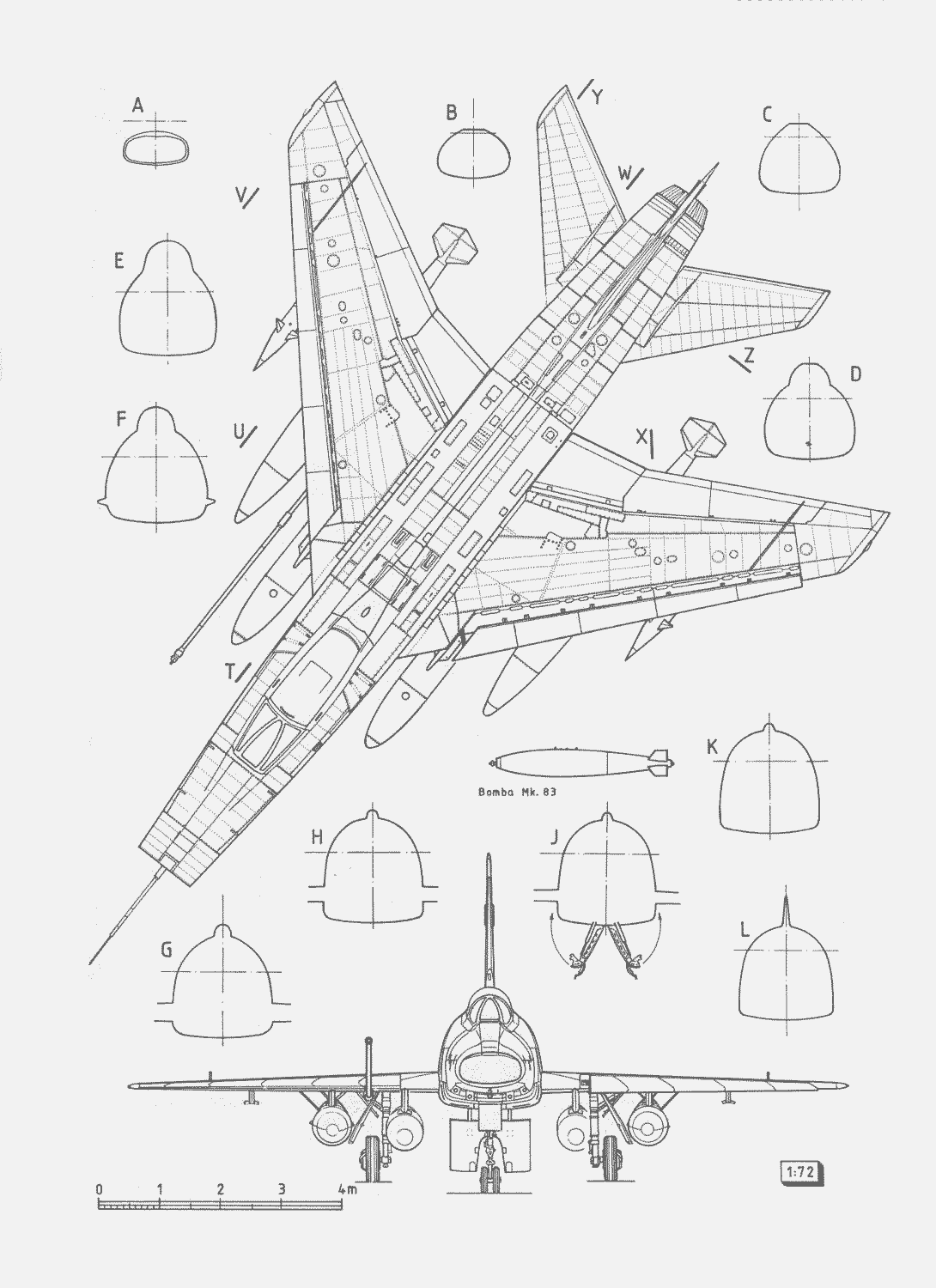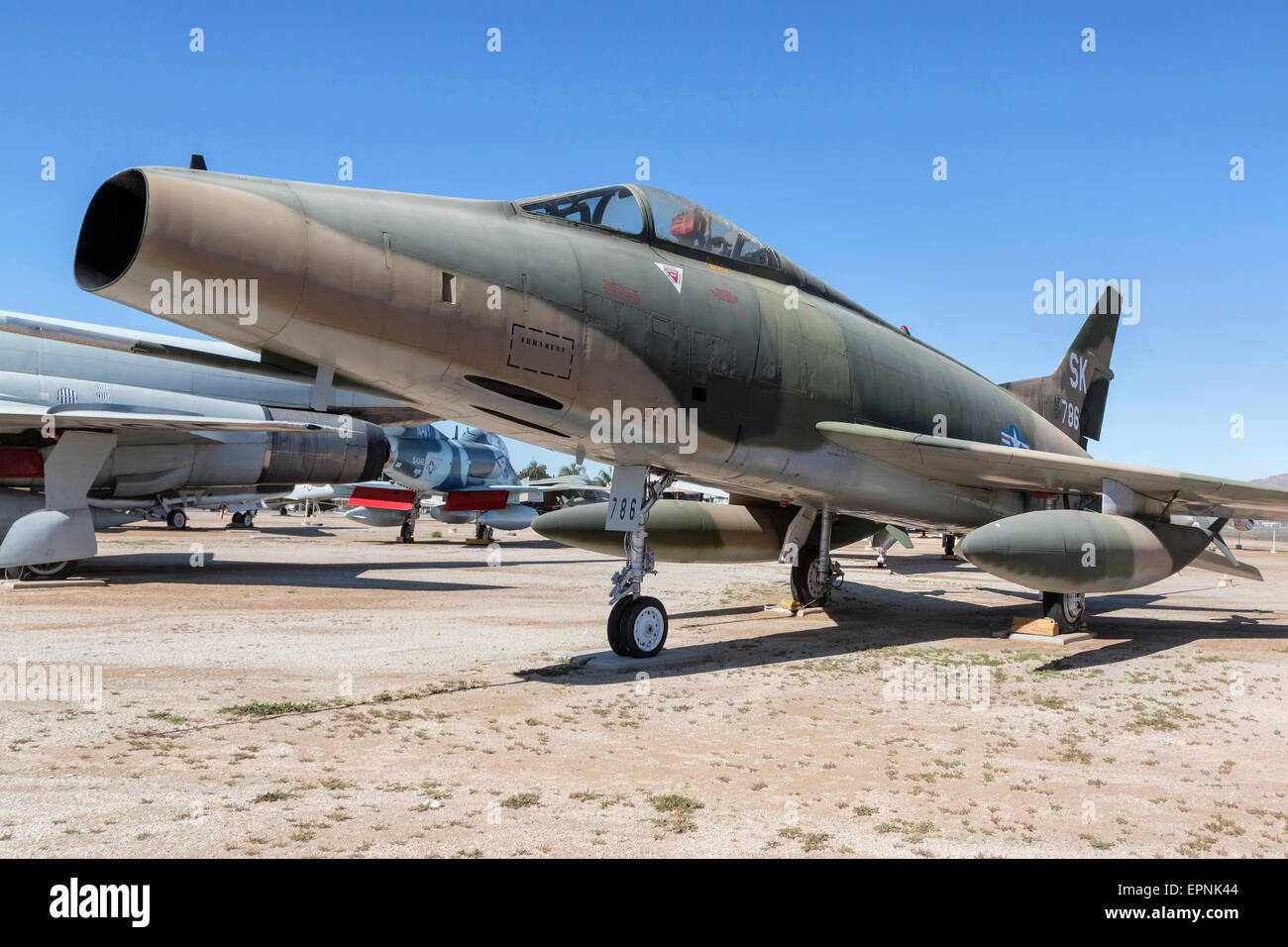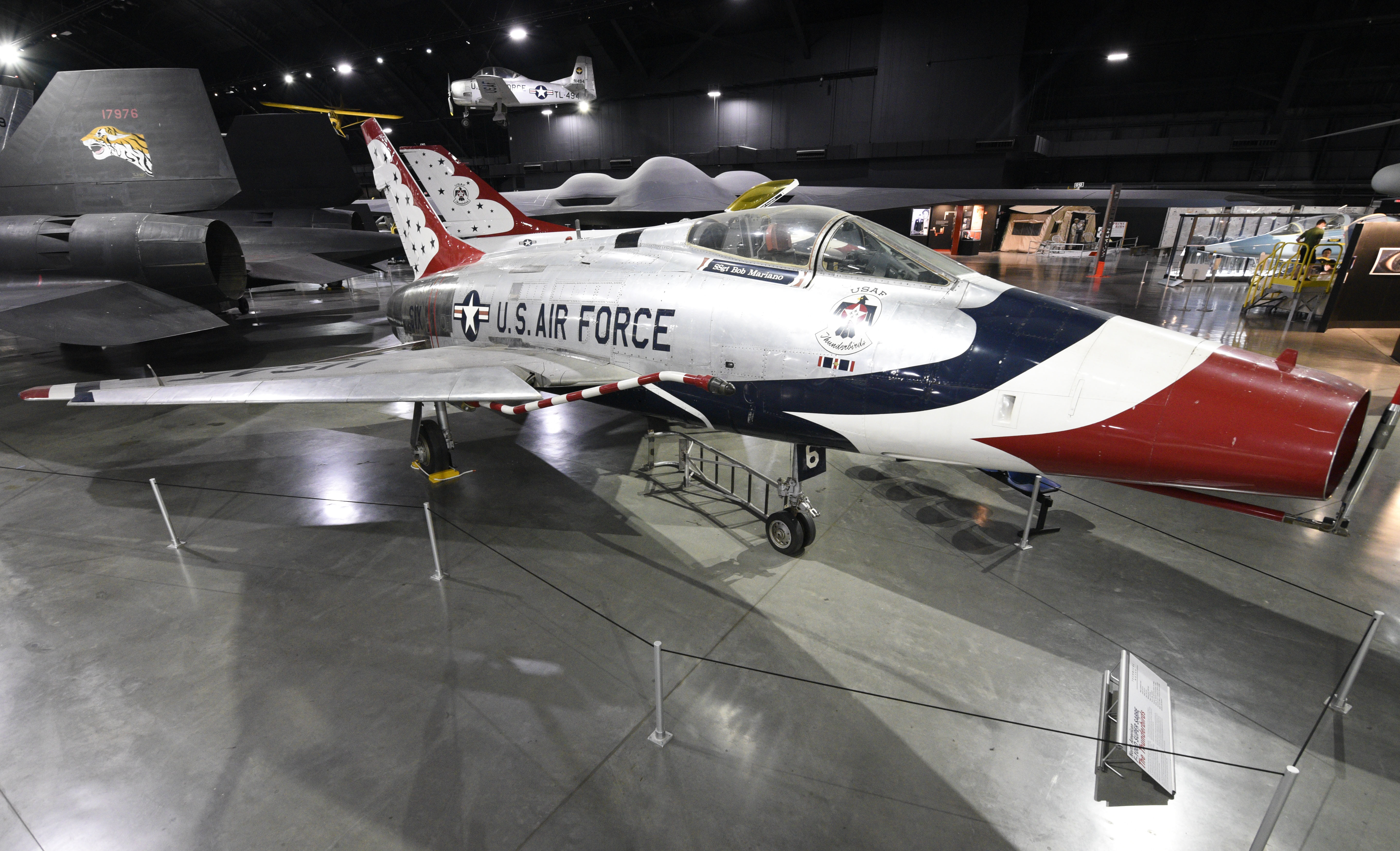F-100 Super Saber - The North American F-100 Super Saber is a fighter aircraft developed by North American Aviation in the late 1940s.
This was the first successful attempt to build a supersonic fighter jet at high altitude. The sound barrier was broken by this device in May 1953 and the Super Saber set a world record on October 29, 1953 when it reached a speed of 1,217 km/h. In 1954, the aircraft entered service with the US Air Force. For the factory, it was the successor to the F-86 Sabre.
F-100 Super Saber

Despite the successful flight, several early crashes resulted in the aircraft being grounded in 1954 due to high-speed instability; an effect called inertial coupling. It was only removed after the manufacturer made changes to the wing tips and enlarged the tailgate. The Super Saber was produced until May 1959. A total of 2,294 units rolled off the production line.
Monogram F 100 Super Sabre Bouwdoos Vliegtuig
From 1954 to 1971, the F-100 was in intensive service with the US Air Force. It continued to be used to provide air support during the Vietnam War. It was later replaced by the Chance Vought A-7 Corsair in the US Air Force.
The F-100 is also flown by various NATO air forces. The aircraft served the French Air Force until 1972, the Danish Air Force until 1982, and the Turkish Air Force until 1985. US aircraft stationed in Europe are based at the following airports:
The F-100 Super Saber is also known as Supsab and Hun. Both are abbreviations, similar to Super Saber and Hundred.
The aircraft in the photos is the F version, a coach version with two seats. The C and D versions were flown in Vietnam as fighter-bombers. They are located at the following airports:
Just A Really Nice F 100 Super Sabre Artwork I Found.
The aircraft successively flew for the USAF, the French Air Force and again for the USAF. On January 20, 1988, the aircraft was deposited on behalf of the United States Air Force Museum. Eight years later, the F-100D arrived in the Netherlands and received the livery of the 32 Fighter Interceptor Squadron at Sosterberg from 1956 to 1960. air superiority. Therefore, it must be capable of taking out enemy aircraft. Speed is important here. It was the first plane to break the sound barrier in level flight. In 1953, the Super Saber broke the speed record by flying 1217 km/h!
The US Air Force used the F-100 during the Vietnam War, among other things. American F-100s are also based at NATO bases in Europe.
The F-100 parachuted into Sosterberg Air Force Base. The three green stripes on the tail are characteristic of 32 Squadron. (Source: NIMH)

The plane is distinguished not only by its appearance, but also by its sound. He makes a lot of noise! The F-100 crashed through the sound barrier, causing the windows to shatter several times. However, the deaf voice is called the "Voice of Freedom".
F 100 Super Sabre: The First Supersonic Fighter
Our museum's F-100 has been sitting outside for years and is in poor condition. Fortunately, over nine hundred donors helped us restore the Super Saber to its former glory. The plane has been in the workshop for more than half a year. At the beginning of May the plane returned to Soesterberg and we immediately gave it a good place in our museum. From now on, everyone can see Super Saber!
"Fast, Fast, Fastest: 'Hun' Ushers in the Era of Supersonic Flight." Alfred Starman - Core Collection North American F-100 Super Saber is an American supersonic jet fighter aircraft that served the United States Air Force (USAF) and Air National Guard (ANG) from 1954 to 1971. The Ctury series of USAF jet fighters is the first USAF fighter capable of supersonic flight at this level.
The F-100 was developed by North American Aviation as a successor to the F-86 Saber air superiority fighter.
Adapted as a fighter-bomber, the F-100 was replaced by the high-speed Republic F-105 Thunderchief for strikes in North Vietnam. The F-100 flew in South Vietnam as the Air Force's primary close support aircraft until it was replaced by the more effective LTV A-7 Corsair II.
Taiwan Air Force North American F 100 Super Sabre Photo By Kwan Lok Ng
The F-100 is also in service with other NATO and other US air forces. allies. In his later life, he was often referred to as "gun", a shortened version of "face".
In January 1951, North American Aviation submitted an unexpected proposal to the United States Air Force for a supersonic aircraft. Named the Saber 45 because of its 45° wing sweep, it represents an evolution of the F-86 Sabre. The layout was tested on July 7, 1951, and after more than 100 changes, the new aircraft was accepted as the F-100 on November 30, 1951. Extensive use of titanium was observed in the aircraft.
On January 3, 1952, the USAF ordered two prototypes, followed by 23 F-100As in February and an additional 250 F-100As in August.

The YF-100A first flew on May 25, 1953, seven months ahead of schedule. It reached Mach 1.04 on this first flight, despite the XJ57-P-7 engine failure. The second prototype flew on October 14, 1953, followed by the first production F-100A on October 9, 1953. USAF operational tests from November 1953 to December 1955 found the new fighter to be efficient, but declared that it is not ready for widespread use. deploymt due to various design flaws. These findings were later confirmed during Project Hot Rod's operational fitness testing.
Snp North American F 100f Super Sabre Bundle Paper Model
Six F-100s arrived in August 1954 at Eglin Air Force Base Air Proving Ground Command (APGC). The Air Force Operational Test Cter (AFOTC) will use four fighters for operational suitability testing, and the remaining two will undergo armament tests at the Air Force Armament Cter. The AFOTC Tactical Air Unit is conducting APGC testing under the direction of Lt. Col. Hry W. Brown of the project office. The initial evaluation was completed by APGC personnel at Edwards Air Force Base.
In particular, the instability of the curves in certain flight conditions is a concern, causing inertial coupling. The aircraft may suddenly pitch and roll, too quickly for the pilot to correct, and quickly damage the aircraft structure. In these conditions, North American Chief Test Pilot George Welch died on October 12, 1954, while testing an early production F-100A (s/n 52-5764).
Another control problem arises from controlling the characteristics of a swept wing at high angles of attack. As the aircraft approached, it lost wingtip lift and developed a severe pitch. This particular fomon (not enough time to recover, and at low altitude can easily cause death) is known as the "Dance of Patience".
However, delays in the Republic F-84F Thunderstreak program forced the Tactical Air Command (TAC) to order the crude F-100A into service. The TAC also requested that future F-100s be fighter-bombers capable of delivering nuclear bombs.
Super Sabre's Service In South Vietnam
Unlike modern stabilizers that use an antiservo tab, springs are mounted on the control stick to increase resistance to pilot input.
The North American F-107 is a Mach 2 upgrade from the F-100, with the air intake moved above and behind the cockpit. It was not issued in favor of the Republic F-105 Thunderchief.
The F-100A officially entered USAF service on 27 September 1954 with the 479 Fighter Wing at George AFB, California. On November 10, 1954, the F-100A experienced six major accidents
Flight instability, structural failure, and hydraulic system failures prompted the USAF to ground the fleet in February 1955. Center 479 finally became operational in September 1955. Due to current problems, the USAF to phase out F-100A. In 1958, the last aircraft left active service in 1961. During that time, 47 aircraft were lost in major accidents.
Super Sabre Magic, Dean Cutshall's F 100 Returns
A situation exacerbated by the construction of the Berlin Wall in August 1961 forced the USAF to withdraw the F-100As from active service in early 1962. The plane was finally retired in 1970.
A request for a TAC fighter-bomber was flown in March 1954 and received by the 450th Fighter Wing, Foster AFB, Texas on 14 July 1955 with an F-100C. Operational testing in 1955 showed that the F-100C was, at best, an interim solution, sharing all the shortcomings of the F-100A. The updated J57-P-21 engine has increased performance but continues to suffer from compressor engines, but the F-100C is considered an excellent platform for nuclear blasts due to its high speed. The inertial coupling problem was reasonably solved by installing a drill damper on the 146th's F-100C, which was later retrofitted to the earlier aircraft. Starting with the 301st F-100C, each aircraft cost $10,000.
Adding "wet" hardpoints F-100C 275 US. gal (1,040 L) and a pair of 200 US. gal (770 l) licorice plant. However, as the combination lost directional stability at high speeds, the four tanks became 450 US. gal (1730 l) licorice plantations.
Sig p365 tulster holster, sig p365 iwb holster, sig holsters p365, sig p365 sas holster, sig p365 xl holster, sig p365 hybrid holster, appendix holster sig p365, safariland holster sig p365, sig p365 belt holster, sig p365 holster, sig p365 purse holster, sig sauer p365 holster

0 Comments